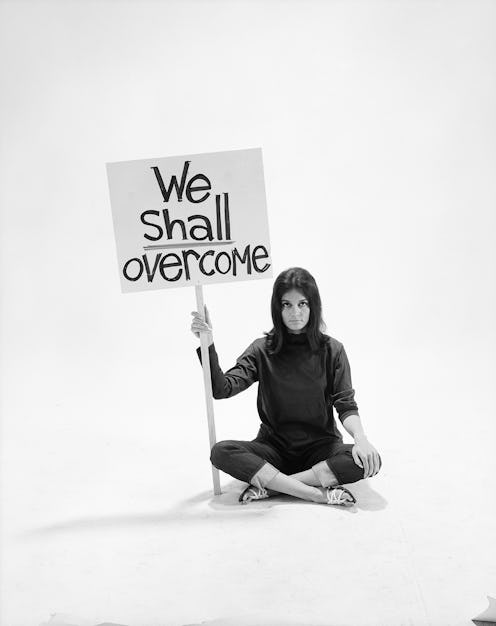In advance of Saturday’s march, we overheard a young woman asserting that protests were pointless. She posited that they don’t effect change so much as they provide Instagram opportunities for those who need to mix up their latte-and-succulent shots with something less outwardly self-serving. While it’s true that some modern participants may be in it for the photo opp, we can assure you that protests were effecting change long before anyone thought to hashtag them; here, nine life-changing things the women’s movement accomplished, many of which were achieved by the same means citizens are using now (on both sides of the aisle) to stand up for what they believe is right.
The Real Story
It's pretty crazy to think that women have only had the right to vote in America for 100 years. In 1890, after several decades of mobilizing, the National American Woman Suffrage Association formed under the leadership of Susan B. Anthony. Members of this group and the National Woman's Party, a more militant group formed in 1916, were arrested repeatedly for attempting to vote and for picketing the white house. Some were force fed in jail while engaging in hunger strikes, an extreme protest tactic they borrowed from the Russians. The woman's suffrage amendment was first introduced to Congress in 1878 by a friend of Anthony but did not become the 19th amendment until 1920. This was after nearly a century of organization, protestation and imprisonment by women outraged by inequality.
Before the women's movement of the 1960's and 1970's, women in America were largely expected to get married in their twenties, settle down as homemakers, and be subservient to their husbands. In 1960, only 38% of women worked, and the majority of them worked as secretaries and other such low-level jobs approved for women at the time. Luckily some woke AF ladies, spurred into action by Betty Friedan's book The Feminine Mystique, which opened a dialogue on domestic discontent for the first time, organized into one of the most famous feminist movements in history. The National Organization of Women, founded in 1966, lobbied Congress for pro-equality laws and provided legal aid for women fighting workplace discrimination. As a result of all of these hard-won battles, women actually outnumber men in the workplace these days. Many people also credit birth control for this massive shift. Introduced in 1960, we owe birth control to a rebellious woman named Margaret Sanger, who was jailed several times for her activism, played a role in the repeal of the Comstock Act (which made it illegal to promote or distribute birth control of any kind) and underwrote the research which led to the creation of the first birth control pill.
In 1970, Betty Freidan organized a protest known as The Women's Strike For Equality March, wherein 50,000 women showed up to block traffic in NYC. Thousands of women in other cities also organized sister marches. (Sound familiar?) Says Time , "The organizers of the day’s events agreed on a set of three specific goals, which reflected the overall spirit of second-wave feminism: free abortion on demand, equal opportunity in employment and education, and the establishment of 24/7 childcare centers. Over the next several years, activists would use multiple techniques — from public protest to legislative lobbying — in an attempt to turn these goals into realities." As a result, in 1971, Congress passed the Comprehensive Childcare Development Act, which would have created a national day care system designed to make it easier for parents (read: mothers) to work outside the home. Nixon, however, vetoed the bill in 1972.
In the early 1960's, many of the women who would later lead and join the women's movement cut their teeth by marching on behalf of the Civil Rights Movement—both activist contingents helped advance each others causes considerably. Even earlier than this, women played a large role in the Anti-Slavery Movement in the early and mid 1800s. Additionally, many of those within the Civil Rights Movement specifically were women who did not necessarily receive recognition for their actions.
You can see Gloria Steinem discuss the link between LGBTQ rights and women's rights here and read more about their specific intersection here. As they did with the Civil Rights Movement, women have sought to unite with other marginalized groups like the LGBTQ community in order to have a more substantial voice against the perceived patriarchy. To this day this tradition continues, with women who marched on Washington (and other cities) in January calling on their ranks to protest discrimination against the transgender community.
Don't feel bad if you didn't know there was also an Anti-Rape Movement in the 1960s and 1970s, especially given this is most definitely a battle we are still fighting today. This movement changed the definition of rape—"It was founded with the conceptions that sexual violence and violence against women more generally is a tool of social control used to keep women in a subordinate position to men, and that women need to do something that aids victims of sexual violence to become "survivors" of violence instead of victims."
Sexual harassment was legally defined in 1980, after tireless work by the feminist movement, which created the term. The women's movement also defined the term "domestic abuse" for the first time, made spousal abuse illegal and opened the first shelters for women. (Are you getting goosebumps yet???)
We won't get into how dangerous abortion was for women before Roe v. Wade—in the '60s, a group of feminists without any sort of medical training learned how to perform abortion procedures, which they did in secret in ever-moving home locations around New York City—this was one of the safer avenues available to women. The Roe v. Wade decision, which legalized first-term abortion in 1973, was the result of legal strategizing by the National Organization of Women and others.
Justice Anthony Kennedy essentially credited feminism for changing the legal definition of marriage when ruling on marriage equality.
